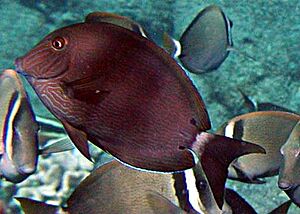Bluelined surgeonfish facts for kids
Quick facts for kids Bluelined surgeonfish |
|
|---|---|
 |
|
| Conservation status | |
| Scientific classification | |
| Synonyms | |
|
The bluelined surgeonfish (scientific name: Acanthurus nigroris) is a type of marine fish. It belongs to the family called Acanthuridae. This family includes other cool fish like surgeonfishes, unicornfishes, and tangs.
For a while, scientists thought this fish was the same as another one, A. nigros. If they are the same, this fish lives all over the Indo-Pacific region. But if they are different species, the bluelined surgeonfish only lives around the United States Pacific islands.
What's in a Name?
The bluelined surgeonfish was first officially described in 1835. A French zoologist named Achille Valenciennes gave it its scientific name. He found it near the Hawaiian Islands.
Later, in 1861, another scientist named Albert Günther described a similar fish. He called it Acanthurus nigros. For many years, scientists thought these two fish were the same species.
But in 2011, new studies looked at the fish's DNA. These studies showed that A. nigros is actually a separate species. So, the bluelined surgeonfish is now considered its own unique species.
Why is it Called That?
The scientific name nigroris comes from two Latin words. Niger means "black" and oris means "mouth". So, the name means "black mouth".
Valenciennes, the scientist who named it, described the fish as having black lips. However, you can't see these black lips on living fish. They might have appeared black because of how the fish was preserved in alcohol.
What Does it Look Like?
The bluelined surgeonfish is a pretty fish. It has a dorsal fin (on its back) with 9 strong spines. It also has between 23 and 26 soft rays in this fin. Its anal fin (on its belly) has 3 spines and 22 to 24 soft rays.
The fish's body is usually a light to dark brown color. It has thin, dotted blue lines that run across its body. These lines are a bit wavy. There are also blue lines on its head, below its eye, and on its gill cover. These lines go towards its snout.
You can often see a black spot on the back part of both its dorsal and anal fins. This spot is smaller than half the size of its eye. Sometimes, it also has a thick whitish bar on its caudal peduncle (the narrow part before the tail).
The dorsal and anal fins have reddish-brown bands. They also have a thin blue edge. The caudal fin (tail fin) has a thin white edge at the very back. This fish can grow up to about 18 centimeters (7 inches) long.
Where Does it Live?
The bluelined surgeonfish lives in the central Pacific Ocean. It is mainly found around the Hawaiian Islands and Johnston Atoll.
This fish is not picky about where it lives. You can find it in different places in the ocean. It lives in lagoons, on reefs that face the open sea, and in areas with sand, rocks, and broken coral.
Bluelined surgeonfish often swim in schools. These schools can be small, with just a few fish, or very large, with hundreds of fish! They like to eat filamentous algae (a type of seaweed) and tiny living things called plankton.


